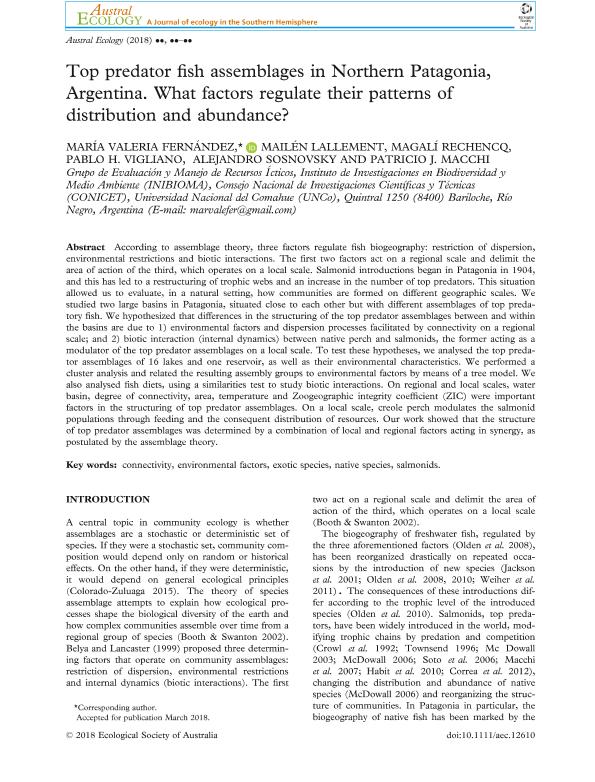Artículo
Top predator fish assemblages in Northern Patagonia, Argentina. What factors regulate their patterns of distribution and abundance?
Fernández, María Valeria ; Lallement, Mailén Elizabeth
; Lallement, Mailén Elizabeth ; Rechencq, Magali
; Rechencq, Magali ; Vigliano, Pablo Horacio; Sosnovsky, Alejandro
; Vigliano, Pablo Horacio; Sosnovsky, Alejandro ; Macchi, Patricio Jorge
; Macchi, Patricio Jorge
 ; Lallement, Mailén Elizabeth
; Lallement, Mailén Elizabeth ; Rechencq, Magali
; Rechencq, Magali ; Vigliano, Pablo Horacio; Sosnovsky, Alejandro
; Vigliano, Pablo Horacio; Sosnovsky, Alejandro ; Macchi, Patricio Jorge
; Macchi, Patricio Jorge
Fecha de publicación:
23/09/2018
Editorial:
Wiley Blackwell Publishing, Inc
Revista:
Austral Ecology
ISSN:
1442-9985
Idioma:
Inglés
Tipo de recurso:
Artículo publicado
Clasificación temática:
Resumen
According to assemblage theory, three factors regulate fish biogeography: restriction of dispersion, environmental restrictions and biotic interactions. The first two factors act on a regional scale and delimit the area of action of the third, which operates on a local scale. Salmonid introductions began in Patagonia in 1904, and this has led to a restructuring of trophic webs and an increase in the number of top predators. This situation allowed us to evaluate, in a natural setting, how communities are formed on different geographic scales. We studied two large basins in Patagonia, situated close to each other but with different assemblages of top predatory fish. We hypothesized that differences in the structuring of the top predator assemblages between and within the basins are due to 1) environmental factors and dispersion processes facilitated by connectivity on a regional scale; and 2) biotic interaction (internal dynamics) between native perch and salmonids, the former acting as a modulator of the top predator assemblages on a local scale. To test these hypotheses, we analysed the top predator assemblages of 16 lakes and one reservoir, as well as their environmental characteristics. We performed a cluster analysis and related the resulting assembly groups to environmental factors by means of a tree model. We also analysed fish diets, using a similarities test to study biotic interactions. On regional and local scales, water basin, degree of connectivity, area, temperature and Zoogeographic integrity coefficient (ZIC) were important factors in the structuring of top predator assemblages. On a local scale, creole perch modulates the salmonid populations through feeding and the consequent distribution of resources. Our work showed that the structure of top predator assemblages was determined by a combination of local and regional factors acting in synergy, as postulated by the assemblage theory.
Palabras clave:
CONNECTIVITY
,
ENVIRONMENTAL FACTORS
,
EXOTIC SPECIES
,
NATIVE SPECIES
,
SALMONIDS
Archivos asociados
Licencia
Identificadores
Colecciones
Articulos(INIBIOMA)
Articulos de INST. DE INVEST.EN BIODIVERSIDAD Y MEDIOAMBIENTE
Articulos de INST. DE INVEST.EN BIODIVERSIDAD Y MEDIOAMBIENTE
Citación
Fernández, María Valeria; Lallement, Mailén Elizabeth; Rechencq, Magali; Vigliano, Pablo Horacio; Sosnovsky, Alejandro; et al.; Top predator fish assemblages in Northern Patagonia, Argentina. What factors regulate their patterns of distribution and abundance?; Wiley Blackwell Publishing, Inc; Austral Ecology; 43; 6; 23-9-2018; 651-662
Compartir
Altmétricas



